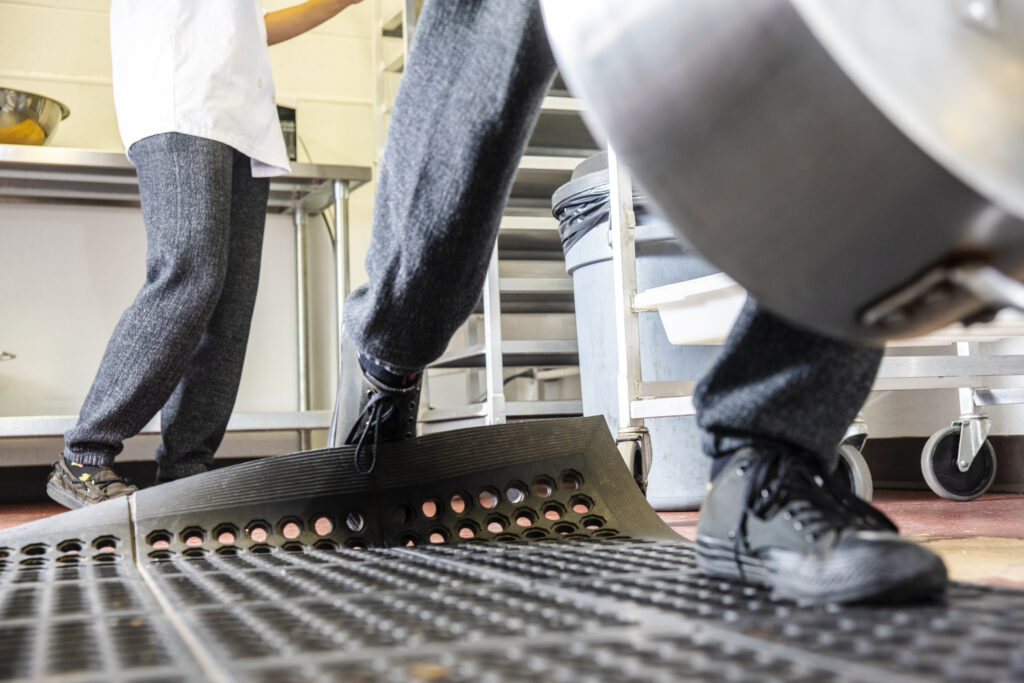Slips and falls are one of the greatest risks in the restaurant and food service industry, where hazards are everywhere. Water, ice, grease, and other spills on the floor, combined with the heavy traffic that restaurants experience, can all increase the risk of accidents and slip and fall claims.
The National Safety Council estimates that over 25,000 slip and fall accidents occur at restaurants across the U.S. These kinds of accidents often lead to severe injuries and costly insurance claims. Now is the time for businesses to review how to reduce the risk of accidents and if they require additional protection against insurance claims.
Why do slips and falls occur in the dining industry?
The restaurant and food service industry is extremely hectic, with workers moving quickly to meet customer demands. This means that any obstructions can and will cause accidents, increasing the risk of slip and fall claims. Common hazards include:
- Floor composition: Floors are regularly cleaned and vary in their slip-resistance when wet or soiled. Some hard surface floors may be slip-resistant when dry but very slippery when liquids are spilled. Restaurants must be aware of the slip-resistance of their floors. Mats are often placed to mitigate these issues, but all mats will wear and tear over time, even though restaurants rarely replace them.
- Uneven surfaces: Steps, raised or recessed ledges, loose carpeting with upturned edges, and overall cleanliness can create an uneven surface.
- Obstructions: One common risk is tools and equipment left in unsafe areas. Hoses, cords, wires, and even wet floor signs can contribute to a hazardous walking area.
- Visibility: Too-bright lights, shadows, poor lighting, glare, strobe lights, and extreme color contrasts can all hinder visibility for both customers and employees.
- Human error: While slips and falls can affect anyone, the elderly face the most significant risk. Older patrons are more likely to fall due to mobility and balance problems. In addition, they are more likely to be seriously hurt when they slip.
An unsafe flooring area is a risk for both employees and customers. Prevention is vital to ensuring the safety of everyone in the restaurant and food service industry.
Also read: Protect Your Business with a Restaurant Food Safety Checklist
What can employers do to encourage safe practices in their restaurants?
Safety starts with a strong understanding of how to prevent accidents from happening. The likelihood for slip and fall claims drastically reduces if the premises is safe.
- Create a preventative slip, trip, and fall management strategy. Include a complete outline of the establishment, detailing the main areas prone to accidents. The plan should break down the precautions employees should take and the response to any accident as it occurs. Make inclusions for policies outside the restaurant as well, including steps, walkways, sidewalks, and parking lots. Accidents in parking lots cause 51% of slip and fall claims.
- Ensure non-slip materials are installed in areas with heavy footfall. Mats and floor coverings should be placed in spillage-prone areas like behind bars or in the kitchen. Also, add water-absorbing mats to the entrances and exits of establishments, and maintain their upkeep. Mats are like car tires, requiring regular checks to ensure they aren’t worn out and need replacement.
- Use technology to your advantage. There is software designed to simulate situations in the restaurant, providing feedback on where to implement improvements. Cameras can also observe high-risk areas and monitor locations constantly to alert employees of spills or other situations that could lead to accidents.
- Invest in training for your employees. The same technology used to map out risk areas can inform workers where to focus cleaning efforts. Hazard awareness is also an effective training course to avoid slip or fall injuries. When employees are hired, ensure they receive safety orientation training on the most accident-prone areas of the establishment.
Also read: Why Assault and Battery Insurance is Essential for Bar and Restaurant Owners
What can employees do to prevent slips and falls?
With proper training, employees can be equipped to identify and handle risks before they turn into accidents. A few tips for them to follow include:
- Cleaning up any spills immediately, even if the restaurant is busy.
- Maintaining clean work areas.
- Wearing slip-resistant shoes or non-slip overshoes if restaurant-safe footwear isn’t available.
- Maintaining accident-prone areas, like sidewalks and stairs.
- Clearing clutter away as soon as it’s identified.
- Placing warning signs for customers and other employees.
- Sweeping and mopping the floor with clean water and appropriate cleaning products that do double duty, cleaning the floor while also providing traction.
- Never run in the facility or kitchen to avoid collisions.
- Ensure that tables and chairs are put back into place between customers coming and going.
Through an overhaul of safety regulations from management, refresher courses on hazard awareness, and following common safety tips, the restaurant and food service industry can drastically reduce the risk of insurance claims related to slips and falls.
Slip and fall claims: Why you need insurance
However, even with robust safety practices, slips and falls are still likely to occur. The food service industry is estimated to spend more than $2 billion each year on these claims, and the rate is rising by 10% every year.
No plan is perfect, and accidents will happen. Restaurant owners should invest in a comprehensive insurance policy to protect them from slip and fall claims. This will ensure that when accidents do happen, the resulting litigation won’t be financially crippling.
McGowan’s Restaurants, Bars, & Taverns Insurance offers a wide range of coverage options for businesses looking to meet the unique needs of the restaurant and food service industry. Find the necessary coverage for any food enterprise, from restaurants to gastro pubs, and protect your business from the risks of accidents in the workplace.


